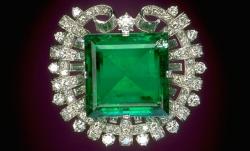Emeralds

"Roman author Pliny the Elder, who died in the 79 CE eruption of Mt. Vesuvius, wrote in his encyclopedic Natural History that “nothing greens greener.” He also stated that the May birthstone had therapeutic properties that helped gem cutters: “(they) have no better method of restoring their eyes than by looking at the emerald, its soft, green color comforting and removing their weariness and lassitude.” Science now proves this belief: The color green relieves stress and eye strain." - May Birthstone. gia.edu
The word "emerald" comes from the Ancient Greek word smaragdos, (meaning a green gem) via Old French, Middle English, Colloquial Latin and Latin. It is a member of the Beryl family, along with Aquamarine and Morganite, and even though it rates rather high on the Mohs scale, 7.5-8, Emeralds' resistance to breaking is lower than you would think.

One of the characteristic features of Emeralds is that they naturally contain inclusions and microcracks. Almost no "perfect" Emeralds are ever found. There are no alluvial deposits of Emeralds so the only way to mine them is to explode the hard rocks surrounding them. This invariably leads to microcracks being formed in the Emerald. The tiny cracks may not be noticeable, but they can weaken the structure of the stone.

Another circumstance that weakens the strength of an Emerald is ironically the same thing that makes it an Emerald in the first place - it's colour; or more specifically, the element that gives the Beryl the powerful green colour during formation, i.e. Chromium (Cr). Chromium is responsible for the Emeralds' famous green hue, but also distorts the stone’s crystalline structure, making it more fragile.
NOTE: It is for these reasons that jewellers are very hesitant in resetting Emerald jewellery. The risks are higher than Sapphire or Ruby, and there is always a chance that with the pressure involved in resetting a stone, microcracks could appear.
Emerald specialist George Smith of the International Emeralds Exchange shared his perspective: “It is very important to treat your emerald with care in order to reduce the likelihood that it will need additional cleaning. I believe that, in some cases, emerald can be a gem for everyday wear – it really depends on the setting. If the stone is exposed, the chance that you will catch it on something and damage it is higher, but if the setting envelops the stone from all sides, protecting the corners, one can certainly wear it daily and not merely on special occasions.”

With all this is mind, care must be taken with your Emerald jewellery, despite the high position on the Mohs scale. If you need to clean your Emerald jewellery at home, it is safest to use a microfibre cloth to regularly keep it clean. Do not use any chemicals or soaps, but use a cotton bud or cotton wool dipped in warm water. Emeralds need to be stored carefully, and should not be worn while showering, washing dishes or playing sport or any activity that risks exposing them to additional damage.
- Birthstone - May
- 20th & 35th Wedding Anniversary
- 65th Jubilee
- Mohs Scale - 7.5 - 8
- Suitable for daily wear - depending on setting
- Can scratch Glass
Information from GIA; photo - Hooker Emerald Brooch